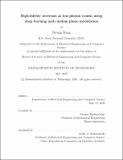| dc.contributor.advisor | George Barbastathis. | en_US |
| dc.contributor.author | Kang, Iksung. | en_US |
| dc.contributor.other | Massachusetts Institute of Technology. Department of Electrical Engineering and Computer Science. | en_US |
| dc.date.accessioned | 2020-09-15T21:53:19Z | |
| dc.date.available | 2020-09-15T21:53:19Z | |
| dc.date.copyright | 2020 | en_US |
| dc.date.issued | 2020 | en_US |
| dc.identifier.uri | https://hdl.handle.net/1721.1/127346 | |
| dc.description | Thesis: S.M., Massachusetts Institute of Technology, Department of Electrical Engineering and Computer Science, May, 2020 | en_US |
| dc.description | Cataloged from the official PDF of thesis. | en_US |
| dc.description | Includes bibliographical references (pages 65-70). | en_US |
| dc.description.abstract | Often objects are highly transparent or pure phase with no absorption of ambient light; phase information of the objects conveys most of the knowledge on their appearance. Phase is generally retrieved from raw intensity, e.g. holographic or ptychographic measurements, longitudinal intensity variation, or a single diffraction pattern without a reference beam. In this inversion problem, imaging with small number of photons is of particular importance because it minimizes the radiation induced damage onto the objects. However, any images captured with a detector are incoherently influenced by Poisson statistics on top of Gaussian noise due to the quantum nature of photo-electric conversion in the detector, and estimates of the inversion problem become more sensitive to artifacts under low-photon condition. Some state-of-the-art techniques, e.g. | en_US |
| dc.description.abstract | deep neural networks (DNN) with no physical constraint or iterative algorithms with intermediate phase modulation, have been used to get an inverse of the raw intensity with a faith that the noise sources will be coped with these methods. However, unwanted residual artifacts still remain in their reconstructions, hampering overall reconstruction fidelity. Here, in this thesis, we address the use of the Coherent Modulation Imaging (CMI) scheme for phase retrieval together with a Deep Neural Network (DNN) inverse algorithm for photon-limited applications. Our motivations are grounded by some previous works: (1) The CMI scheme incorporates random phase modulation into an optical system at an intermediate location between the objects and detector, and thus effectively reduces system ill-posedness [Zhang et al, 2016]; and (2) DNNs have been proven to be an effective inversion method under low-photon conditions, with some limitations [Goy et al, 2018]. | en_US |
| dc.description.abstract | In this thesis, we will first describe a systematic way of finding the optimal placement of the random modulation in the free space between object and detector, and present experimental results with extensive qualitative and quantitative analysis. | en_US |
| dc.description.statementofresponsibility | by Iksung Kang. | en_US |
| dc.format.extent | 70 pages | en_US |
| dc.language.iso | eng | en_US |
| dc.publisher | Massachusetts Institute of Technology | en_US |
| dc.rights | MIT theses may be protected by copyright. Please reuse MIT thesis content according to the MIT Libraries Permissions Policy, which is available through the URL provided. | en_US |
| dc.rights.uri | http://dspace.mit.edu/handle/1721.1/7582 | en_US |
| dc.subject | Electrical Engineering and Computer Science. | en_US |
| dc.title | High-fidelity inversion at low-photon counts using deep learning and random phase modulation | en_US |
| dc.type | Thesis | en_US |
| dc.description.degree | S.M. | en_US |
| dc.contributor.department | Massachusetts Institute of Technology. Department of Electrical Engineering and Computer Science | en_US |
| dc.identifier.oclc | 1192483310 | en_US |
| dc.description.collection | S.M. Massachusetts Institute of Technology, Department of Electrical Engineering and Computer Science | en_US |
| dspace.imported | 2020-09-15T21:53:19Z | en_US |
| mit.thesis.degree | Master | en_US |
| mit.thesis.department | EECS | en_US |
